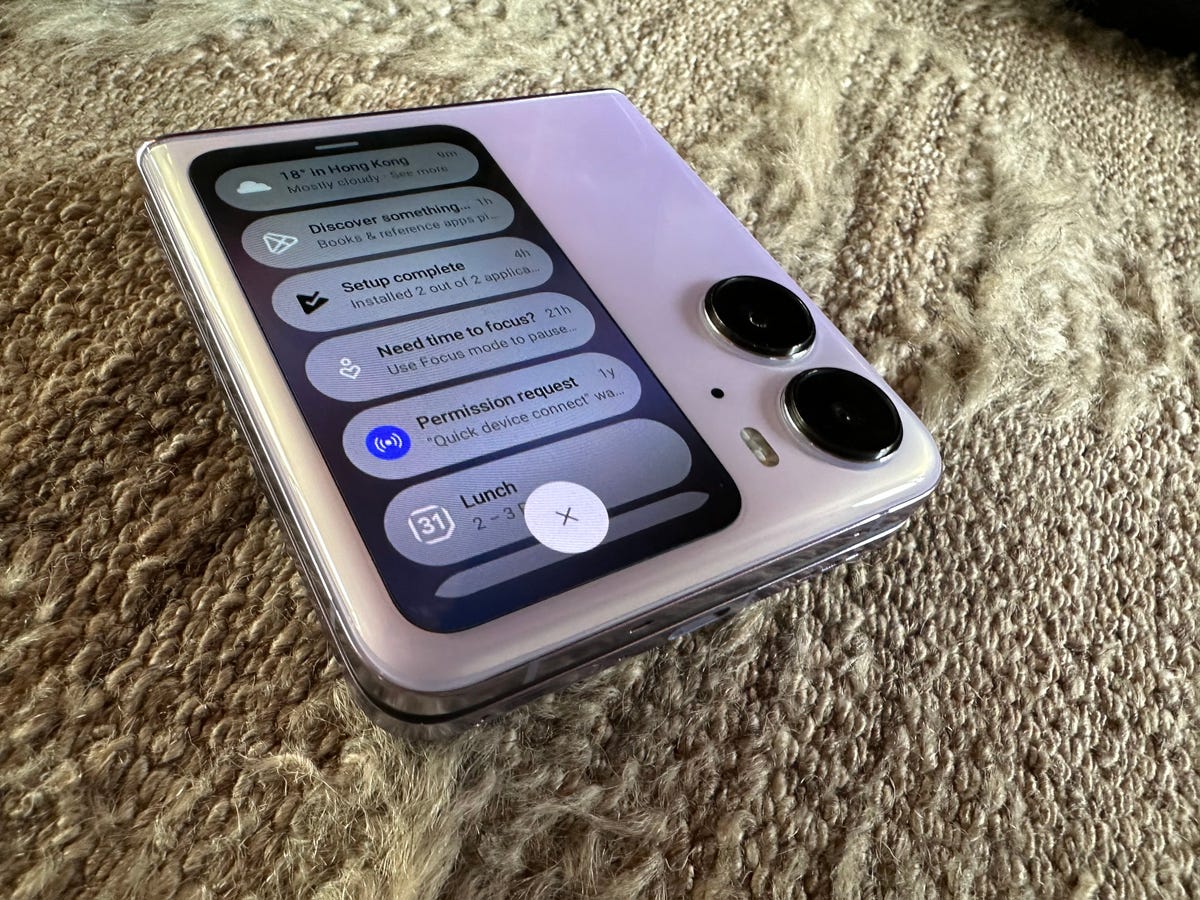Technologies
New Foldable Phones Convinced Me Two Screens Are Better Than One
Commentary: With the Galaxy Z Flip 5, Motorola Razr Plus and Google Pixel Fold, tech giants are closer to proving that foldable phones can be truly useful.

Foldable phones have been around for almost half a decade, but they still account for only a small portion of the mobile phone market. There are a few good reasons why: Such phones are expensive, less durable than standard mobile devices and have a visible crease running across their displays.
But most importantly, foldable phones still lack a so-called «killer app:» An app or feature that defines their purpose and is compelling enough to convince people to buy them. With new foldables like the Samsung Galaxy Z Flip 5, Motorola Razr Plus and Google Pixel Fold, tech giants are taking a step toward changing that. And the «killer app» may not be an app at all, but rather a secondary screen.
All three phones share a common theme that stretches beyond their foldable shape. Samsung, Google and Motorola are all exploring the usefulness of having two screens on your phone instead of just one. Each phone has an external cover screen that’s large enough to comfortably use apps without opening the phone. Google, Samsung and Motorola also take that idea a step further by experimenting with how those two screens can be used in tandem to enhance photography and other features.
While phones like the Z Flip 5, Razr Plus and Pixel Fold are still new, I’m already starting to see the promise behind having a phone with two screens that can serve different purposes.
The Galaxy Z Flip 5 and Motorola Razr Plus may be the best examples of this so far. Both devices have external screens that are roughly the same size as the display on an iPhone 4. That’s considered tiny by today’s standards, but these screens are large enough to send text messages, browse directions on Google Maps, take selfies and scroll through news headlines without opening the phone.
Flip phones with cover screens like these are a great middle ground between a smartwatch and a smartphone. After years of using phones with giant screens that measure 6 inches or larger, I appreciate having a screen that fits in the palm of my hand. And unlike a smartwatch, I don’t have to twist my wrist to read an email or check my calendar.

The Pixel Fold’s cover screen didn’t leave as strong of an impression on me as the Razr Plus’ or Z Flip 5’s, but it’s still one of the few advantages it has over Samsung’s Galaxy Z Fold line. The outer display on the Pixel Fold has a wider shape, more closely resembling a regular phone when closed. That goes a long way in making the Pixel Fold feel more natural, enabling it to strike a better balance between tablet and phone. While the main internal display on the Z Fold looks better than the Pixel Fold’s in terms of brightness and boldness, Samsung’s external display feels elongated and skinny compared with the Pixel Fold. As a result, it’s less enjoyable to use in phone form.
However, there’s more potential behind these dual-screen designs that companies like Samsung, Google and Motorola are just starting to tap into. What I’m most excited about is the way these cover displays and internal screens may work together in the future. Motorola and Samsung are starting with the camera. Both phones can show a preview of a photo before you hit the shutter button, letting friends and family see how they look before the image is captured.
Google is launching a language translation feature in Android 14 that incorporates both the external and internal displays. In practice, the external display facing the other person would show your speech translated into text in the other participant’s native language. The internal screen facing you would show the other person’s speech translated into your native language. I haven’t tried this yet, but the idea feels like a fresh departure from other software features we’ve seen arrive on foldables in recent years.

Samsung and Motorola aren’t the first to put larger cover screens on flip phones. Nor was Google the first to put a wider front display on a book-style foldable. (Chinese tech giant Oppo actually beat them on both counts.) But the fact that companies like Samsung, Motorola and Google are adopting these approaches indicates the broader foldables market may move in this direction.
And that’s good news, because previous foldables simply didn’t feel radically different enough to justify their high cost compared with cheaper, non-folding phones. These dual-display phones represent a step toward changing that, showing that foldable devices have more to offer than just a big screen that fits in your pocket.
Technologies
These Anker Earbuds Are Down to $57 — and Even Amazon Couldn’t Resist Matching the Price
Grab yourself a solid pair of earphones that offer excellent noise cancellation and battery life.

There are plenty of earbud options out there, but finding the right ones for you can feel nearly impossible as a result. But if you’re after some of the best noise-canceling wireless earbuds and you’d like to save some money, we might have the answer for you.
Best Buy is running a one-day sale on the excellent Anker Soundcore Liberty 4 NC earbuds, knocking the price to just $57 — which matches the lowest price we’ve seen yet. And Amazon’s price-matching. With a 43% discount, now’s the time to grab a pair before this limited-time deal disappears.
These earbuds have 11mm drivers, as well as hi-res wireless, LDAC technology and adaptive noise canceling that should reduce noise from your environment by up to 98.5%, according to Anker. That means you can stay immersed in the music (or other content you love) regardless of what’s going on around you.
Plus, because they’re equipped with six mics, they offer good call quality, regardless of your environment. We found them comfortable, too, and loved the bass they put out.
Hey, did you know? CNET Deals texts are free, easy and save you money.
The Liberty 4 NC earbuds have an impressive battery life as well, offering up to 10 hours of playback per charge, with an additional 50 hours available with the charging case. And just 10 minutes of fast charging can get you up to four hours of playback. They’re also rated IPX4 water-resistant, so any inclement weather while you’re out shouldn’t cause these buds any harm.
Another great feature these earbuds offer is multipoint connection, which lets you connect to your phone and your computer at once, which is super convenient. That’s a lot of features for earbuds this affordable.
If you’re not totally sold on this model, be sure to check out our roundup of all the best headphone and earbuds deals happening now.
HEADPHONE DEALS OF THE WEEK
-
$300 (save $51)
-
$299 (save $151)
-
$220 (save $180)
Why this deal matters
These excellent earbuds are now available at their record-low price. Best Buy is limiting this discount to a one-day sale, and we expect Amazon to end the deal around the same time, so be sure to grab a pair before this opportunity expires.
Join Our Daily Deals Text Group!
Get hand-picked deals from CNET shopping experts straight to your phone.
By signing up, you confirm you are 16+ and agree to receive recurring marketing messages at the phone number provided. Consent is not a condition of purchase. Reply STOP to unsubscribe. Msg & data rates may apply. View our Privacy Policy and Terms of Use.
Technologies
The Apple Watch Ultra 3 Just Got Its First Proper Discount, but It Won’t Last Long
The latest rugged smartwatch from Apple is yours for just $700 right now.

The Apple Watch Ultra 3 has only been on sale for a few weeks, but it’s already available for its first real discount. Getting one of the best smartwatches money can buy isn’t going to be cheap, but this deal saves you $99 off the usual asking price. But be warned, we don’t expect this early Black Friday deal to last long.
The result? You’ll pay just $700 for your new Apple Watch Ultra 3, with a couple of colors and band combinations available. These prices often fluctuate, so we suggest checking out all available pairings before placing your order. Apple Watch Ultra 3 deals are likely to come and go quickly.
All Apple Watch Ultra 3 models come with cellular modems inside so you can connect them to your carrier — assuming it supports the Apple Watch’s eSIM. That’ll allow you to stay connected even when you don’t have your iPhone with you.
Hey, did you know? CNET Deals texts are free, easy and save you money.
The Apple Watch Ultra 3 comes in a large 49mm size, so it’s easy to read. Despite that huge display, Apple Watch Ultra 3 owners can expect long-lasting battery life. In fact, the Apple Watch Ultra 3 can run for up to 42 hours in normal mode and a whopping 72 hours in its low-power mode.
This being an Apple Watch, it comes with all of the usual health and fitness monitoring features, as well as sleep tracking. It can monitor your heart rate, track your progress thanks to its precise dual-frequency GPS, and do a whole lot more.
If the standard Apple Watch models can’t quite live up to your busy, active lifestyle, this is the model for you. Be sure to order your new smartwatch before this deal expires.
SMARTWATCH DEALS OF THE WEEK
-
$329 (save $100)
-
$200 (save $100)
-
$200 (save $100)
-
$500 (save $150)
Why this deal matters
The latest Apple Watch Ultra 3 is the best of its kind. It has a new display that’s designed to be easier to read and has an impressive battery life. It isn’t the cheapest smartwatch on the market, but if you want the best that Apple has to offer, now is the time to place your order — before this deal ends.
Looking for savings on other models? Check out all the best Apple Watch deals happening now.
Join Our Daily Deals Text Group!
Get hand-picked deals from CNET shopping experts straight to your phone.
By signing up, you confirm you are 16+ and agree to receive recurring marketing messages at the phone number provided. Consent is not a condition of purchase. Reply STOP to unsubscribe. Msg & data rates may apply. View our Privacy Policy and Terms of Use.
Technologies
Here’s the Best Time to Spot November’s Supermoon, the Brightest Moon of 2025
Does the moon look brighter and bigger? It’s not just you — here’s why this month’s supermoon is even more super.

November is a great month for skygazers, featuring a trio of meteor showers and the return of the northern hemisphere winter constellations. This week, it also features the second of four consecutive supermoons. This month’s supermoon will happen on Nov. 4-5, and November’s beaver moon is special because it’ll be the brightest full moon of 2025.
Don’t miss any of our unbiased tech content and lab-based reviews. Add CNET as a preferred Google source.
In addition to being a supermoon, November’s full moon is known as the beaver moon. There is some debate as to why it was named this way. Some believe that this was the best time of year in the old days to set beaver traps to get pelts for winter clothing. Others believe that it coincides with the busiest part of the year for beavers, who are now stocking their lodges with supplies for the upcoming winter.
The brightest supermoon: When’s the best time to see it?
The moon will reach peak illumination at 8:19 a.m. ET on Nov. 5, making the evening of Nov. 4 and the morning of Nov. 5 the best times to view the moon.
Since moon phases shift slowly, the moon will appear almost full for nearly a week. If you are unable to view the full moon on its best night due to weather or other reasons, you can still see a mostly full moon at any point from Nov. 3 to Nov. 8.
For all of those days, the moon will be measurably brighter in the night sky compared to any other full moon in 2025. The reason for this is because of the moon’s elliptical orbit. Since it’s not a perfect circle, the moon’s 27.3-day journey around the Earth brings it closer to us on some days, a phenomenon known as perigee. If there is a full moon during this time, it’s branded as a «perigean full moon,» which you may know better as a supermoon.
Not all supermoons are equal, and November’s will be a little more special than others. According to The Farmer’s Almanac, the beaver moon will be a scant 221,817 miles away from Earth, making it the closest full moon of the year. That means it’ll be the biggest and brightest of the year.
In practice, the differences are fairly minor and likely won’t be visible to the naked eye when compared side by side to other supermoons. A supermoon is only about 7% larger than a regular full moon. According to NASA, the biggest difference is when comparing a supermoon to a micromoon, where a supermoon will be about 14% larger and 30% brighter. So, if you notice that your backyard patio is lit up more than usual, it’s because of the supermoon.
Also due to the moon’s orbit, November will also bring a micro new moon, which means the moon will be as far away from the Earth as it can get — a phenomenon known as apogee. November’s new moon occurs on Nov. 20, but you won’t be able to see it.
-

 Technologies3 года ago
Technologies3 года agoTech Companies Need to Be Held Accountable for Security, Experts Say
-

 Technologies3 года ago
Technologies3 года agoBest Handheld Game Console in 2023
-

 Technologies3 года ago
Technologies3 года agoTighten Up Your VR Game With the Best Head Straps for Quest 2
-

 Technologies4 года ago
Technologies4 года agoVerum, Wickr and Threema: next generation secured messengers
-

 Technologies4 года ago
Technologies4 года agoBlack Friday 2021: The best deals on TVs, headphones, kitchenware, and more
-

 Technologies4 года ago
Technologies4 года agoGoogle to require vaccinations as Silicon Valley rethinks return-to-office policies
-

 Technologies4 года ago
Technologies4 года agoOlivia Harlan Dekker for Verum Messenger
-

 Technologies4 года ago
Technologies4 года agoiPhone 13 event: How to watch Apple’s big announcement tomorrow
